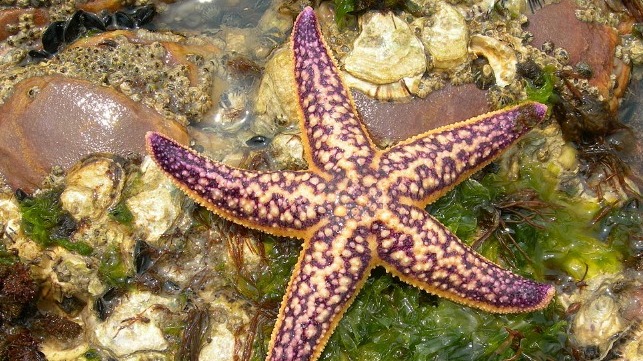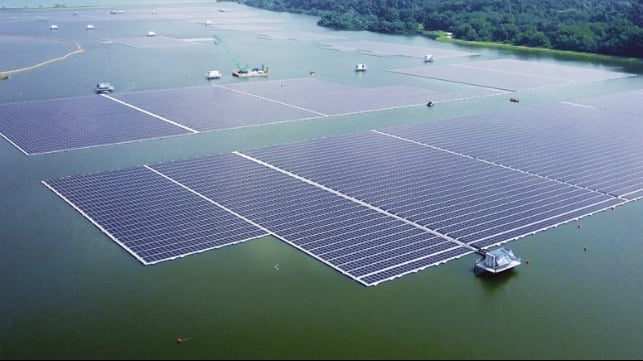What is Causing Plagues of Sea Stars?

"Lots of attention is paid during an outbreak, but the seastars soon disappear,” said one researcher at the Yellow Sea Fisheries Research Institute of the Chinese Academy of Fishery Sciences. Commenting on a plague of Northern Pacific seastars (Asterias amurensis) that struck Shandong’s Jiaozhou Bay in March, she said the species is a regular presence that occasionally explodes in number before returning to normal. This is common for seastar species, she added, but a lack of research and funding means there is little understanding of why these outbreaks occur.
So the March outbreak, which happened 14 years after the last such incident, came as something of a surprise. The seastars munched through huge quantities of farmed oysters and clams, prompting the government to temporarily allow use of the banned cage net, nicknamed the “extinction net”. A survey by the local marine development authorities at the peak of the outbreak found 50 Northern Pacific seastars every square metre. An area of 100,000 mu (66.7 square kilometres) was affected, slightly larger than Beijing within the 2nd Ring Road. Losses were valued at 100 million yuan (US$15.5 million).
Jiaozhou Bay, with its moderate water temperatures and numerous nutrient-rich river inflows, is ideal for shellfish farming. According to local aquaculture experts, shellfish have been farmed there for 30 or 40 years. Commonly, they are seeded and raised in shallows and allowed to grow naturally. That makes them easy prey for seastars.
The Northern Pacific seastar invaded the coastal aquaculture beds of Jiaozhou Bay in 2006 and 2007, hitting abalone and Manila clam farming particularly severely. These were the first large-scale seastar incursions of these beds, according to a 2008 paper by Wang Yingeng of the Yellow Sea Fisheries Research Institute.
At the time, researchers knew little about the species and could not explain the cause of the sudden outbreak. Unfortunately, they couldn’t provide definitive explanations for this year’s outbreak either. Zhang Guangtao, a researcher at the Chinese Academy of Sciences’ Institute of Oceanology, thinks researchers should monitor seastars to understand their migration paths and the patterns of outbreaks.
Why now, again?
For shellfish farmers, the Northern Pacific seastar and other seastar species are no better than locusts. Zhang Guangtao said seastars are voracious carnivores, willing to eat various prey and prone to catching more than necessary. So, when the seastars come by, no shellfish is left behind.
Researchers who investigated the site of the outbreak told a local newspaper that there could be three causes for the March outbreak: the tendency for seastars to converge on food-rich areas; reductions in the number of natural predators; and changes in the ocean environment.
On the first point, Zhang Guangtao points out that the Northern Pacific seastar mainly eats shellfish, so outbreaks are concentrated where shellfish are farmed. “If there’s lots of food, there’ll be lots of seastars,” he said. As for natural enemies, he explained that the 1–2 year growth cycle of a seastar commences with a month or two as a larval form before developing into the familiar star shape. The seastar larvae have many predators, including fish such as the yellow croaker, perch and flounder. But adult seastars have few.
Wang Yingeng’s paper blamed the 2006 and 2007 outbreaks on a reduction in the number of natural predators. Overfishing has reduced the number of carnivorous fish. Gulls and otters eat adult seastars, but climate change and damage to the ocean environment have reduced their numbers too. This has allowed seastars which previously lived in deeper waters to thrive in shallower coastal zones.
As for the ocean environment, the researchers investigating the scene of the outbreak said changes in nutrient levels, PH and temperature can all create conditions which help seastars proliferate.
Zhang Guangtao disagrees that ocean acidification due to climate change is helping young seastars survive. He said that while there is evidence changes in PH level can affect the plankton which seastar larvae feed on, how much it impacts the larvae is uncertain and requires more research.
A lack of research and monitoring data means it’s hard to say what caused the current outbreak. “The reasons offered are just conjectures by researchers,” warned Zhang.
Clockwork seastars?
After decades of observation, researchers in Australia have discovered that some seastar outbreaks run to a regular schedule; specifically, the crown-of-thorns starfish (Acanthaster planci), which eats coral polyps and so causes coral bleaching, earning the nickname “the coral killer”.
Australian researchers have identified four crown-of-thorns outbreaks around the Great Barrier Reef, in the 1960s, late 1970s, early 1990s, and an ongoing outbreak which started in 2010. Outbreaks in some areas occur every 15 years, and every 10-12 years in others. In most cases, they cause serious damage to the Great Barrier Reef.
Since 2005, Li Yuanchao and other researchers at the Hainan Oceans and Fisheries Institute have been monitoring the coral reef ecosystems of the Xisha (Paracel) Islands. Field studies and archival research identified two crown-of-thorns outbreaks there. The first began in 2004 and its impact on coral reefs continued until 2019. Then a fresh outbreak occurred, also in 2019.
Given these findings, and the Australian research, Li’s team published a paper in 2019 saying crown-of-thorns outbreaks in Xisha occur approximately every 15 years.
Other species appear in regular cycles due to inherent biological traits. For example, the eastern US is currently experiencing an outbreak of a kind of “periodical cicada”, which emerges in its hundreds of millions in the spring of every 17th year, to mate, give birth and die within a matter of weeks.
But there is not yet scientific consensus on what causes the periodical outbreaks of crown-of-thorns starfish, according to information from the Great Barrier Reef Marine Park Authority. A number of factors are likely at play. Biological factors could be part of the answer, as could: falls in natural enemy numbers; increased nutrition from rivers and upwelling; the spread of larvae by ocean currents; and availability of coral prey.
Li Yuanchao’s team puts the crown-of-thorns outbreaks down to typhoons, reductions in predatory fish populations on coral reefs, global warming and human activity. Typhoons add nutrients to the water by disturbing the seabed, meaning more starfish larvae survive. Warmer temperatures and reduced fish numbers increase the chances of starfish eggs hatching and surviving. Monitoring data from Li’s team shows warmer temperatures increase survival rates. Average temperatures in the waters around Xisha were over 30C in 2006-2007 and 2014-2018, and starfish numbers increase during these times.
Although there are no conclusions on what causes the outbreaks, Zeng Xiaoqi, a professor at Ocean University of China who researches echinoderms, says there is plenty of monitoring data available on crown-of-thorns, as many countries have started researching them, due to the harm they cause coral reefs. But there is still not enough research into the Northern Pacific seastar, he added.
“There were outbreaks in 2006 and 2007, but we don’t know what was happening previously, or what will happen afterwards,” Zeng said. He points out that both the crown-of-thorns and the Northern Pacific seastar belong to the Asteroidea class, but are different species with different characteristics. They are living in different environments, and the causes and timing of their outbreaks should not be conflated.
More research needed
The Northern Pacific seastar is becoming an ecological disaster across the northern Pacific. In China and Japan alone, there have been 10 major outbreaks since 1953, according to a 2019 paper from researchers at the Chinese Academy of Sciences’ Yantai Institute of Coastal Zone Research and other institutions. Meanwhile, a review of academic research found that little study of the species has been carried out, with no quantitative work on how it is affected by the acidification and warming caused by climate change, or by human activity such as shellfish farming.
When asked about the causes of the latest Jiaozhou Bay outbreak, researchers who have studied the Northern Pacific seastar told China Dialogue they had only done limited research and couldn’t provide definitive answers.
Discussions on the cause of outbreaks of the crown-of-thorns starfish are also still ongoing. Given the destruction they cause to coral reefs, long-term monitoring should begin as soon as possible, according to Lian Jiansheng, a coral researcher at the Chinese Academy of Sciences’ South China Sea Institute of Oceanology.
A lack of funding is one factor holding back research. In his paper, Li Yuanchao wrote that while central and local government allocate some cash for tackling crown-of-thorns outbreaks, this is emergency funding, not designed to help research the mechanisms and causes of outbreaks, the lifecycle of the animal, or possible prevention mechanisms.
Speaking to China Dialogue, researchers repeatedly stressed the importance of tracking and monitoring the seastars. Zeng Xiaoqi thinks the Northern Pacific seastar should be covered by regular monitoring of the coastal environment and organisms, in order to better understand its distribution, breeding and population changes in key areas. Zhang Guangtao added there is a particular need to monitor larvae numbers and how they move, so that the risk of outbreaks can be identified and controlled. He also suggested appropriate releases of seastar larvae predators, such as the yellow croaker, perch and flounder.
Han Qing is a former environmental journalist for Jiemian and Beijing News, with a focus on climate and biodiversity.
This article appears courtesy of China Dialogue Ocean and may be found in its original form here.
The opinions expressed herein are the author's and not necessarily those of The Maritime Executive.









